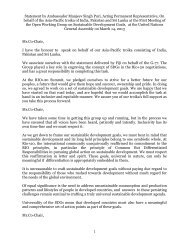STATE OF THE WORLD'S CITIES 2012/2013 Prosperity
STATE OF THE WORLD'S CITIES 2012/2013 Prosperity
STATE OF THE WORLD'S CITIES 2012/2013 Prosperity
You also want an ePaper? Increase the reach of your titles
YUMPU automatically turns print PDFs into web optimized ePapers that Google loves.
Quality of Life: A Variety of Local Responses<br />
UN-Habitat has identified some convergent and divergent<br />
forms in which cities address quality of life.<br />
Divergent city responses: Actions to improve quality of<br />
life will largely depend on the stage of development of the<br />
relevant country or city.<br />
In most poor cities in the developing world, quality of<br />
life is strongly associated with the provision of public goods<br />
in the form of basic services such as water, sanitation and<br />
electricity, and improvements in slum neighbourhoods.<br />
Tanzania’s National Development Vision 2025 aims at<br />
high quality of life for all the population, linking this notion<br />
to economic growth and poverty reduction. 13 In Ho Chi<br />
Minh City, quality of life is directly linked to improved<br />
drainage, sewage collection and treatment systems, and<br />
other public infrastructures such as road enlargements.<br />
In middle-income countries, governments link quality of<br />
life to various factors, from improved living environments<br />
and enhanced material well-being to higher incomes. Experts<br />
in cities as diverse as Fort-de-Fran ce (Martinique), Habana,<br />
Cebu, Davao, and Beirut explicitly refer to the provision of a<br />
decent house and a healthy environment as essential elements<br />
for improved well-being and quality of life. In other cities<br />
−Rosario, Bangalore, Hyderabad, Alexandria and Guarenas<br />
(Venezuela) − improved solid waste disposal is perceived as<br />
a major condition for better quality of life. Improvements<br />
in healthcare services appear as another major factor. In<br />
Singapore, Doha, Chongqing and Shenzhen, local experts<br />
implicitly refer to good and affordable medical services for<br />
all as a good way of improving quality of life. Shenzhen’s<br />
universal healthcare system<br />
and Tehran’s Urban Heart<br />
Programme are good<br />
Box 2.3.2<br />
examples.<br />
POLICy Equitable<br />
cities<br />
generalize access<br />
to urban commons<br />
and public goods,<br />
preventing private<br />
appropriation and<br />
expanding the scope for<br />
improved quality of life<br />
for all.<br />
Quality of Life, World-Class Cities and Social Inclusion<br />
63<br />
FACT<br />
Quality of Life and Urban <strong>Prosperity</strong><br />
Experts in Beira, Algiers, Praia, Luanda and Addis<br />
Ababa, among others, explicitly link improved quality<br />
of life to slum upgrading and poverty reduction.<br />
In rich countries, government responses to the need<br />
for quality of life implicitly refer to access to a number<br />
of goods and services and improvements in the domestic<br />
living environment. Many<br />
European cities emphasize<br />
good transport, green open<br />
spaces, culture and sports<br />
facilities as major factors<br />
behind better quality of life.<br />
Although better paid jobs,<br />
good levels of education<br />
and health facilities always<br />
feature in government<br />
responses, quality of life is<br />
increasingly associated to<br />
an inclusive, well-planned,<br />
healthy and supportive<br />
environment. 14<br />
FACT<br />
Convergent city<br />
responses: Beyond local<br />
circumstances, some<br />
aspects of quality of life<br />
improvements can be found<br />
in all types of country.<br />
Northern<br />
European<br />
cities like Copenhagen,<br />
Amsterdam, Groningen,<br />
Berlin and Muenster<br />
promote cycling and<br />
walking as part of new<br />
urban cultures and in<br />
the pursuit of better<br />
quality of life. Others<br />
like Dresden, Vancouver<br />
and Los Angeles have<br />
launched into urban<br />
conversion programmes<br />
in cultural and historical<br />
neighbourhoods,<br />
adapting urban<br />
infrastructure and<br />
reusing open land<br />
areas for better quality<br />
of life.<br />
Cities with aspirations to ‘world class’ status will typically equate this notion with competitiveness.<br />
The 2007–2015 Dubai Long-term Strategic Development Plan declares these two notions as twin<br />
objectives that will “establish the city as a preferred home for current and future residents by<br />
improving the well-being of citizens and residents, and helping them live healthier lives enriched<br />
with opportunity and choice. 15 In Doha, the capital of Qatar, transformation of the city into a<br />
diversified knowledge-based economy is seen by public authorities as being contingent on the<br />
development and upgrading of the education and skills of the population and improved quality of<br />
life. 16 Singapore considers quality of life as a key competitive advantage to attract skilled foreign<br />
labour and investment. 17 At a different level, a local expert in Beirut noted that ‘quality of life’ mostly<br />
appeared in the advertising brochures of high-end property developments, in response to which<br />
non-governmental organizations have used the same notion to draw attention to the lack of public<br />
goods in the city, such as public or ‘green’ spaces. 18 In Santos, Brazil, quality of life is perceived as<br />
involving social justice and inclusion, not just economic growth, as a precondition for sustainable<br />
development.




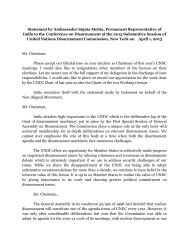
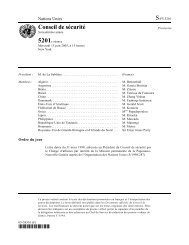
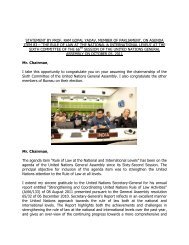
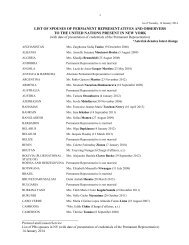
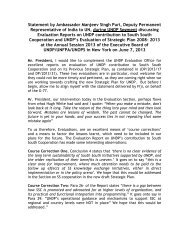
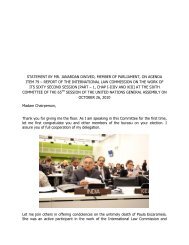
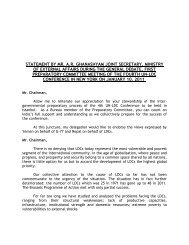
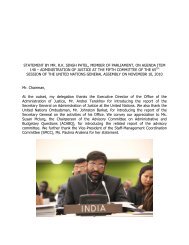

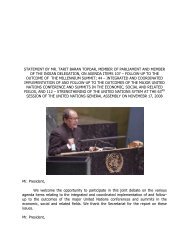
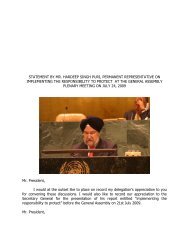
![1 statement by dr.[mrs] kakoli ghosh dastidar - Member States Portal](https://img.yumpu.com/27526598/1/190x245/1-statement-by-drmrs-kakoli-ghosh-dastidar-member-states-portal.jpg?quality=85)
